
Millets are a group of highly variable small-seeded grasses, widely grown around the world as cereal crops or grains for fodder and human food. Most species generally referred to as millets belong to the tribe Paniceae, but some millets also belong to various other taxa.

Pearl millet is the most widely grown type of millet. It has been grown in Africa and the Indian subcontinent since prehistoric times. The center of diversity, and suggested area of domestication, for the crop is in the Sahel zone of West Africa. Recent archaeobotanical research has confirmed the presence of domesticated pearl millet on the Sahel zone of northern Mali between 2500 and 2000 BC.
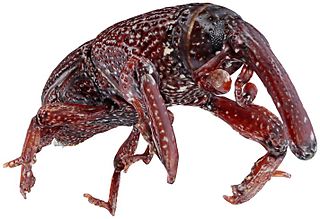
The wheat weevil, also known as the grain weevil or granary weevil, is an insect that feeds on cereal grains, and is a common pest in many places. It can cause significant damage to harvested stored grains and may drastically decrease crop yields. The females lay many eggs and the larvae eat the inside of the grain kernels.

Pelopidas thrax, the pale small-branded swift, millet skipper or white branded swift, is a butterfly belonging to the family Hesperiidae. It is found in Greece, western and south-western Turkey, Israel, Lebanon, Syria, Iraq, Arabia, Africa, Kashmir and the far east. In Greece, it is only known from Samos, Chios, and Rhodes, where it is found at altitudes of sea level to 75 meters.

Cleridae are a family of beetles of the superfamily Cleroidea. They are commonly known as checkered beetles. The family Cleridae has a worldwide distribution, and a variety of habitats and feeding preferences.

Sorghum bicolor, commonly called sorghum and also known as great millet, durra, jowari / jowar, or milo, is a grass species cultivated for its grain, which is used for food for humans, animal feed, and ethanol production. Sorghum originated in Africa, and is now cultivated widely in tropical and subtropical regions. Sorghum is the world's fifth-most important cereal crop after rice, wheat, maize, and barley, with 59.34 million metric tons of annual global production in 2018. S. bicolor is typically an annual, but some cultivars are perennial. It grows in clumps that may reach over 4 m high. The grain is small, ranging from 2 to 4 mm in diameter. Sweet sorghums are sorghum cultivars that are primarily grown for forage, syrup production, and ethanol; they are taller than those grown for grain.
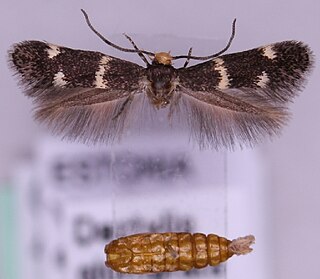
Elachista luticomella is a moth of the family Elachistidae. It is found in most of Europe.
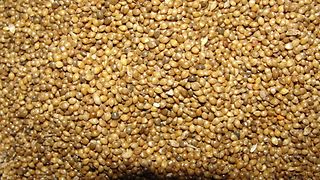
Panicum sumatrense, known as little millet, is a species of millet in the family Poaceae.
Heliocheilus albipunctella, the millet head miner moth, is a moth in the family Noctuidae. It is found in the Sahelian region of West Africa.

Achyra massalis, the ombava, is a moth of the family Crambidae. The species was described by Francis Walker in 1859. It is found in most of the Old World tropics, including Réunion, Namibia and Australia.
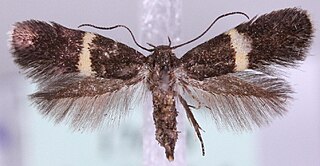
Elachista unifasciella is a moth of the family Elachistidae found in Asia and Europe.
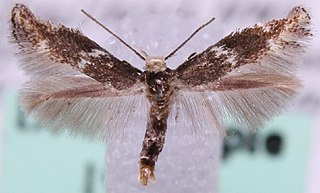
Elachista stabilella is a moth of the family Elachistidae found in Asia and Europe.
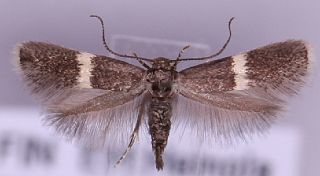
Elachista cingillella is a moth of the family Elachistidae found in Europe.
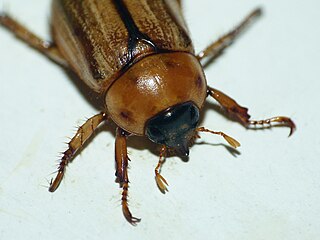
Rhinyptia is a genus of scarab beetles. The genus is characterised by the clypeus narrowing into a long and pointed tip. The male has the outer claw of the mid leg unforked. There are about 20 species in the genus and are found in Asia and Africa.
Chilo infuscatellus, the yellow top borer or sugarcane shoot borer, is a moth in the family Crambidae. It was described by the Dutch entomologist Samuel Constantinus Snellen van Vollenhoven in 1890. It is found in India, Myanmar, Tajikistan, Afghanistan, Korea, Taiwan, Malaysia, the Philippines and on Java and Timor.
Atherigona soccata, the sorghum shoot fly, is a species of fly in the family Muscidae whose larvae feed on the central growing shoots of millet crops like sorghum and finger millet, as well as maize, where they can cause serious loss of yield across Africa and Asia.
Atherigona approximata, the pearl millet shoot fly, is a species of fly in the family Muscidae. The larvae feed on the central growing shoots of crops such as pearl millet and sorghum. It is found in South Asia.
Atherigona miliaceae, the finger millet shoot fly, is a species of fly in the family Muscidae. The larvae feed on the central growing shoots of crops such as finger millet, little millet, and proso millet. It is found in East Asia and South Asia.
Atherigona pulla, the proso millet shoot fly, is a species of fly in the family Muscidae. The larvae feed on the central growing shoots of crops such as proso millet and little millet. It is found in South Asia.











